Where I help out on Sundays we are planning on adding “houseling” cloths, cloths over the Communion rail.
The Communion rail is used at the parish for all Masses. It is wonderful how smoothly, quickly and reverently Communion time goes.
Here is where you readers come in.
If your parish has Communion rail cloths, would you send me photos of how they attach to the Communion rail?
At my home parish in St. Paul, St. Agnes, you can see the cloths hanging behind the rail (which is used). I remember how they are attached (loops on the cloth on hooks).
I have some ideas about how they may be deployed, but I am interested in practical solutions others have adopted.
They are turned over the rail at about the time of the Our Father. This is from the (true) LMS site from few years ago at Ss. Trinità dei Pellegrini. HERE
They are returned to their “dormant” position after Communion.
Thanks in advance.

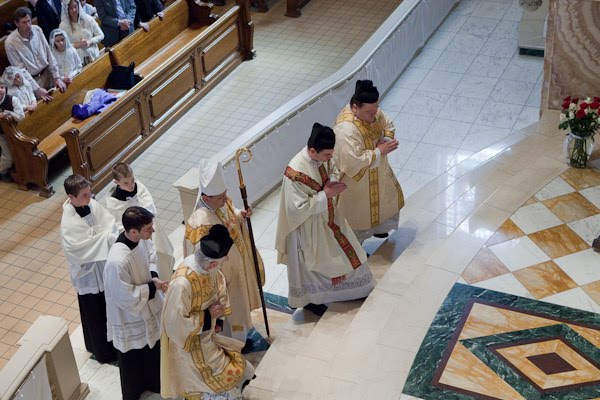
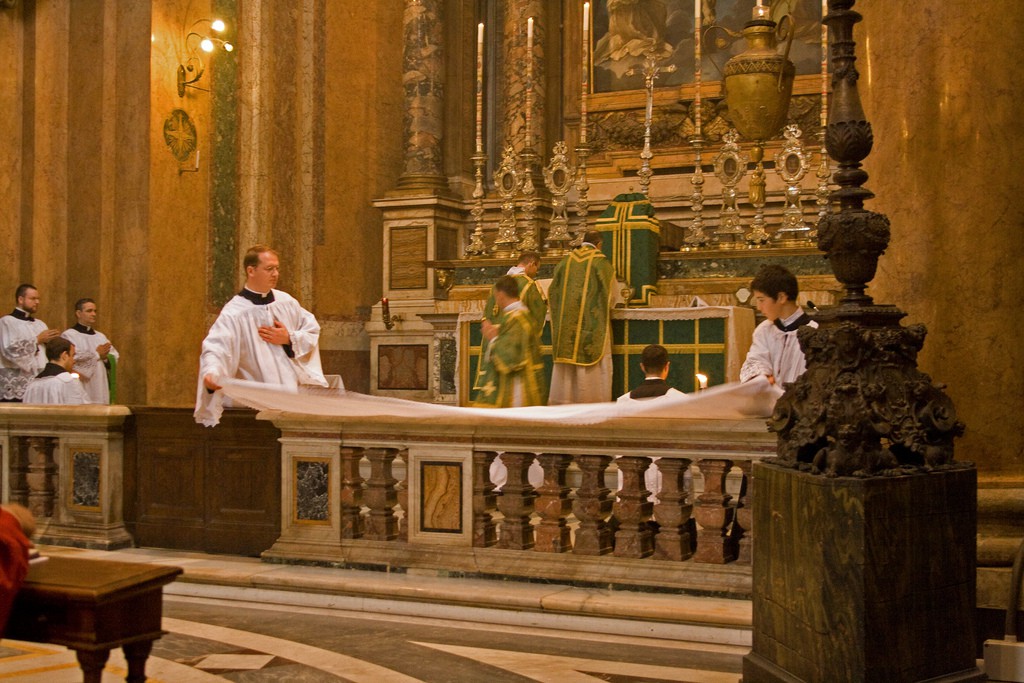



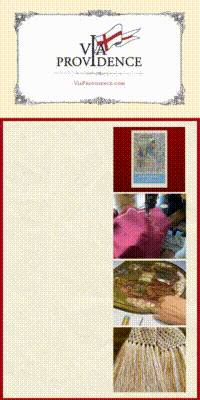

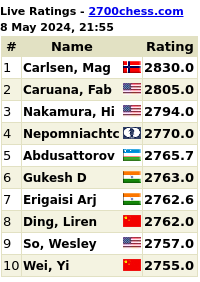













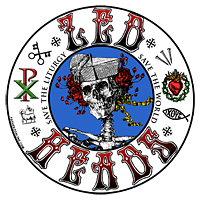




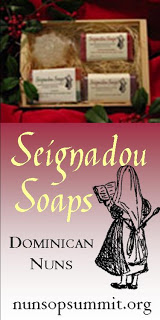





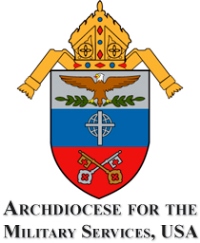

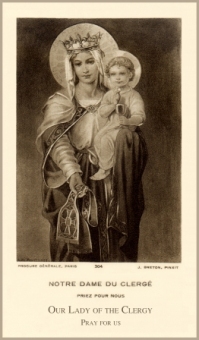
Here the cloths are just there, the whole time during Mass, and I don’t think they are attached in any way.
Which means they are always left a bit disturbed after Communion.
I’ve received communion at a rail with such a cloth. I was instructed to put my hands under the cloth. What is the purpose of them? Since they’re simply flipped back to the “dormant” position after communion, it can’t be an additional safeguard to catch pieces of the Sacred Species, right?
As Msgr. Pope on the Archdiocese of Washington blog noted, the use of the communion cloth was normal until the 19th century. It was only in 1929 that the servers hand paten was required and the cloth began to disappear. There’s a nice mission style Church built in the 1920’s that has the loops on the rail, but anything built after seems to lack them (where the rails weren’t wreckovated, of course).
http://blog.adw.org/2011/11/how-something-we-consider-solidly-traditional-was-once-thought-as-strangely-progressive-barely-to-be-tolerated-a-brief-study-of-the-communion-chin-paten/
Another note is that before St. Pius X, the average Catholic layman only took Holy Communion 4 or 5 times a year. Masses were generally much shorter. Low Mass seems to average 30-45 minutes even as late as 1960.
[On the other hand, I asked a specific question in the top entry.]
St. Mary’s in Rockford, IL attaches the cloth in a similar manner as your parish did. However it is moved over the communion rail at the Angus Dei. You can see how they do this in this video: https://www.youtube.com/watch?v=lBJrDG_Vy-c
This is from our wedding in 1999.
[HOW are they attached? We know that they are turned over the rail. HOW are they attached to the rail?]
Father Z,
Ours are attached with Velcro strips. The cloth has one half sewn on, and the rail has the other half on it (they are longer rails, so I think several good size strips are used. They work well, and it also makes for quick and easy removal for washing. They are probably of good strong quality, because I have never seen them come off easily.
Father Z.,
The loops look fancy, but simply rolling the to edge of the cloth over about an inch and stitching it would work fine. Depending on the make up of the altar rail I have seen either compressible curtain rods or a parachute white cord strung behind the rail. There is usually ample space behind the rail where it is not visible.
fxr2
Sorry, should be: white parachute cord.
fxr2
We sewed a piece of velcro at the top and used stick on velcro for the metal. I really like the idea of loops that you had at St Agnes, but as we had to attach it to metal the most practical way was the velcro. The velcro was sewn on the fabric at the top all the way across.
The best method we’ve found for hanging communion cloths is the screw type altar cloth clamps. They maybe purchased at Mother of Our Savior church supply. http://www.traditionalcatholicpublishing.com/KC-4.html
We used them in my previous parish and are using them in our current parish.
In my present parish the communion rail is marble and could not put screws into the communion rail . Instead clamps were glued to the rail.
Judy
We don’t have the cloth, but I believe the hooks are still there on our communion rail. I will look and take a picture if an image of the hooks sans cloth would be helpful.
[Thanks.]
At the Carmel of Jesus and Mary in NE the sisters use what looks like a curtain rod attached to the back of the communion rail. I forget how the rod was attached, but I think it was a little more permanent than an expandable rod. The cloth hung like a curtain when not in use.
At Holy Redeemer Church there are drapes behind the Communion rail that slide onto rods that sit on hooks. It is a reasonable surmise that this could have originally been for “houseling cloths”. It would not be hard to fasten the rods to the hooks well enough that the rods would not fall off when you fipped the cloths over. Come to Holy Redeemer Church and look at it and you will quickly have an idea how this could work for what you want to do at SMPB. I have a key and could let you in any time. I will be sitting in Holy Redeemer tomorrow afternoon to have the church open to the public and work on painting our nativity statues if you want to visit then.
Of course, an ideal solution is simply come say Mass at Holy Redeemer Church where all this is already set up for you.
ah memories, still in use in our rural parish when I served Mass in the mid sixties, (I was a second grader at the time they were gone 2 years later) it was a matter of pride for us servers to be able to flip the cloth in one smooth motion over the top, one handed other hand on our breast, one server on each end, woe to the server who slacked off and had to do over, the older servers let you have it,
The cloth was held on by spring loaded clips the same as was used in the pews to hold mens hats, sending you a picture by your email, the ladies of the altar society sewed cording on the clip side to help them stay put, only know that because of helping with the stripping of the altar for holy week, for some reason the railing cloth was included at that time
Velcro is your best bet. Easy to install. Easy to remove the cloths when it’s time to clean them, etc. No fuss, no muss.
My recollection from my childhood in West Virginia at the rural church we attended in our mission parish is that the cloth was attached to the back of the wooden railing with thumbtacks.
This was much grander than the big church I attend now, where the marble railing is disassembled and stacked up on the floor in the basement of the church.
What are these for? They seem like a lot of fuss for nothing to me, what am I missing?
I hope Father got the answer to his question.
I stumbled upon this when I was looking for something completely different. It is from a 1949 book titled “Church Linens, a guide for altar societies” from 1949. This is a bit about altar cloths.
—
THE COMMUNION CLOTH AND PATEN The Communion cloth is a plain white linen cloth” attached to the Communion rail on the inside. It should extend the full length of the rail, and be about two feet wide. On March 26, 1929, the Sacred Congregation of the Sacraments issued an Instruction which requires, in addition to the cloth, the use of a Communion paten in the distribution of Holy Communion. “The Communion paten does not do away with the Communion cloth spread at the altar rail. It is an additional pre- caution to safeguard the fragments of the Sacred Species. It is not blessed. Since the introduction of the paten, the faithful no longer hold the Communion cloth; it is laid along the flat top of the rail. This should be observed whether the paten is held by the commuuicants or by a server who accompanies the priest. The Instruction covers another matter that is of im- portance to sacristans, nuns, or anyone else whose duty it is to fill the ciborium with small altar breads. To quote: “In reference to the hosts, the rectors [pastors] shall take care that the fragments that so easily adhere to the hosts are removed, and that, before Mass is celebrated, they are cautiously and carefully brushed off, and if there is a very large number of hosts to be consecrated, they shall be gently shaken in a sieve. The “brushing off referred to above is done with the ?ngers, not with a brush.
—
The phrase “Since the introduction of the paten, the faithful no longer hold the Communion cloth; it is laid along the flat top of the rail” piqued my interest.
How did they hold it? I have only been to one church where they are used and there is the question of hands on top or under the cloth…? I guess the “unders” go back to the tradition of “holding” the cloth…? Did they treat the cloth as we treat the purificator? Was it washed each time?
I suppose those are rhetorical questions. (Insert annoying smiley emoticon here.)